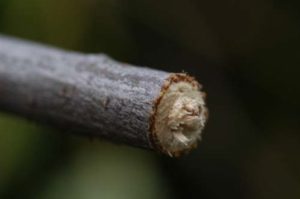You may have asked yourself this exact question recently. After closer inspection of the branches, your next question is probably what in the world caused this buzz saw look to every one of them? It’s the handy work of twig girdlers – a longhorned beetle (Oncideres cingulate).

The adults have a grayish-brown body that is stout and cylindrical. One has but to look at the head of the twig girdler to realize that it is well-equipped for the girdling task. The head is compressed from front to back, and somewhat elongate from top to bottom. This makes it just right for allowing it to fit into the V-shaped girdle it creates.
Twig girdlers have a wide host range including hickory, pecan, oak, maple, hackberry and elm. While hackberry is listed as “high” on the lists of hosts, in Kansas, most reports of littered lawns occurs beneath elms.
So why do they girdle branches? The beetle has a one year life cycle. Late in the growing season, the female deposits eggs in small scars it has chewed through the bark and then chews a continuous notch around the twig girdling it. The notch is cut below the site of egg deposition apparently because the larva is unable to complete development in the presence of large amounts of sap. The larvae of twig girdlers require a “drier wood” for their growth and development.
Girdled twigs die and fall to the ground where the eggs hatch. Girdled twigs look like a beaver has worked on it only in miniature. The outside of the twig is smoothly cut but the center of the twig has a broken appearance. The larvae begin feeding on dead wood inside the twigs the following spring and continue through most of the summer. Pupation takes place inside the feeding cavity. Development is completed during August when the adult emerges to repeat the cycle.
The good news is twig girdlers cause minimal damage the tree – just annoying work for us picking up cut branches! Chemical control is impractical because the adult emergence is lengthy, spanning from August into October. The best control option is to gather up fallen twigs and dispose of them in the fall or spring. This will destroy the larvae inside the twigs. Natural mortality is generally high due to excessive drying of fallen twigs or too many larvae per twig. However, this does not mean that twig girdlers won’t be a problem the following year.
Krista Harding is a K-State Research and Extension Agricultural agent assigned to Southwind District.
She may be reached at [email protected] or 620-244- 3826.
